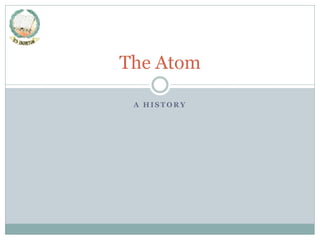
Unit 4. the atom
- 2. VOCABULARY nucleus shell (to) set out (to) make up void lead sheet Foil deflection bounced back tiny (to) drop
- 3. The Atom: What Do You Already Know? In the nucleus, there are ________ and _______. In the outer shell, there are _____________. Different kinds of atoms are categorized using the ___________ Table of Elements.
- 4. History of the Atom When philosophers and physicists set out to study the fundamental units that make up matter, they were essentially all interested in the same question: Where does all of the material in the world come from? What is the most fundamental unit?
- 5. Timeline B.C. Greeks – Fundamental elements make up all matter: air, fire, water, and earth. Middle Ages Alchemists – linked macrocosmic and microcosmic phenomena/workings in universe. 1803 Dalton – Basic Atomic Theory 1898 Thompson – Discovery of electron: Pudding Model 1909-11 Rutherford (1871–1937) – Discovery of nucleus: Planetary Model 1913 Bohr ( 1885-1962) – Discovery of electron orbitals: Quantic Model
- 6. Four Elements Theory Circa 492-432 BC: Greek philosopher Empedocle theorized that all matter came from four basic elements: Earth, Air, Fire, and Water. These elements generated all material things.
- 7. Greek Atomists 420 BCE – The word "atom" comes from the Greek "a-tomos" and signifies "indivisible". Leucippe of Milet invented this idea: there is a tiny, indivisible unit of matter, called the atom. His disciple, Democrite of Abdere thought these atoms were always moving and: Invisible (because of their extremely small size) Indivisible and solid (no void inside)
- 8. Discovery of the Electron 1897 – J.J. Thompson discovered the first component part of the atom: the electron (e-), a particle with a negative (-) electrical charge. J.J.Thompson (1856-1940) The Dalton theory was falling…the atom is divisible. 1904 – He proposed a model of the atom, called "Thompson’s pudding". He imagined the atom as a sphere full of an electrically-positive substance mixed with negative electrons, "like the raisins in a cake".
- 9. Thompson Model: Two Kinds of Pudding English Pudding Traditional dessert. Studded with raisins. Thompson’s Pudding Model Positive solid space, with little negative charges that resemble raisins.
- 10. Ernest Rutherford (1871-1937) A New Zealand-born British chemist and physicist who became known as the E. Rutherford father of nuclear physics. Thomson’s pupil He discovered that the atom’s mass is concentrated in one positive center, called the nucleus in 1911. The Thomson model was passed over. The atoms have space inside. (new idea!) The negative electrons move around the center, a bit like planets around the sun = a “Planetary Model”
- 11. Gold Foil Experiment (1909) 1909 – Rutherford shot alpha particles (positive particles) at a thin sheet of gold foil. He expected many minor deflections. Instead, most of particles passed through, and some were deflected at very large angles. Only some particles even bounced directly back!
- 12. Rutherford’s Planetary Model (1909-11) A comparision Planets Orbit Around Sun The force at work is gravity Electrons Around Nucleus The force at work is electrical attraction between (+) and (-)
- 13. In sumary… Rutherford: his atomic model His new model of the atom showed that its positive electric charge and the majority of its mass were concentrated in a tiny center. The electron in an atom moves around this nucleus like planets around the Sun, the (-) charge of the electron attracting the (+) charge of the nucleus: Atomic Planetary Model Note that Rutherford's atom is: Divisible Contains mostly empty space
- 14. Atomic Planetary Model fails… Rutherford understood that the nucleus is itself composed of nucleons. These nucleons are of two types: positively charged: proton. neutrally charged: neutron The neutron was effectively discovered in 1932 by Chadwick. The planetary model of the atom has a serious deficiency: The electrons can emit light under certain conditions (in an electric light bulb for example); in doing so, they lose energy and should therefore get dangerously close to the nucleus right up until they crash into it! Such an atom would not therefore be stable.
- 15. Niel Bohr (1885–1962): Danish physicist Bohr won the Nobel Prize in 1922. His theory: electrons travel in particular orbits around the atom's nucleus. Bohr also introduced the idea that an electron could drop from a higher-energy orbit to a lower one, in the process emitting a particle of energy (light quantum, called photon) .
- 16. Review: Evolution of the Model of the Atom Scientist Model/Idea 1. Dalton (1803) Discovery of nucleus: 2. Thompson (1897) Planetary Model Electron discovery: Pudding Model Atomic Theory Energy electron discovery: Quantum model 3. Rutherford (1911) 4. Bohr (1913)
- 17. Evolution of Atomic Models Thompson: Pudding Model Greeks: 4 elements B.C. 1898 1913 1803 1911 Dalton’s solid Atom: No spaces Rutherford: Nucleus and Planetary Model Bohr: Quantic Model
- 18. Questions What were the four elements that make up matter, according the Ancient Greeks? Who discovered the electron? Who realized that atoms have a concentrated, positive mass at their center, called a nucleus? How did he discover it? Who was the first person to discover that atoms have space inside? According to Dalton’s atomic theory, are atoms divisible? Which atomic model tastes the best?